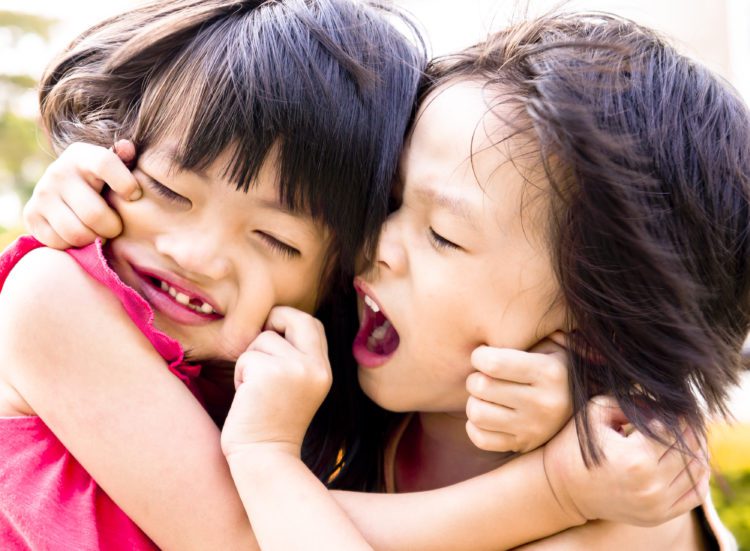Essential Kids Blog, Family Breakdown & Sibling Rivalry, Maggie in the Media, Posts for Parents, Press & Online
Sibling rivalry: one of life’s great teachers

Sibling rivalry is such a hot potato – no matter how many books we read, how much advice we seek or hours spent devising ways to reduce this conflict – it keeps happening.
One study observed that siblings between ages three and seven clash on average 3.5 times per hour.
In a way sibling rivalry is necessary. Our family environment is our greatest classroom for learning how to get along with others.
However, it’s interesting to note research has shown that friendships outside the family may dictate how well first-born children will get on with their future siblings.
In their book, Nurture Shock, Po Bronson and Ashley Merryman reported that the best predictor of how well your siblings are going to get on is the quality of the older child’s relationship with his/her best friend.
So essentially older siblings practise on their friends and then apply what they know and have learnt to their little brothers and sisters.
Now that’s a handy thing to know before you have kids but a bit late when they are all on deck and fighting like hell!
When conflict happens …
Our emotional states come from our thoughts and when we perceive the world is unfair, or that we are excluded rather than embraced and valued, it triggers the primitive mind to perceive a threat and we kick into flight-fight response.
Children and adolescents lack the emotional maturity to perceive accurately the nuances of human behaviour and this is why sibling rivalry is common and indeed normal.
It can occur when there is a change in children’s emotional worlds, like the onset of boredom, hunger, thirst, pent-up energy, power struggles, a game running its course, or when we lose or win too many times.
Fighting siblings often need our help. Essentially creating a return to a calm and centred place should be the first step.
You can teach younger kids the concept of being in a “red room” (when everyone feels angry) or a “green room” (when everyone is calm) to help determine the difference in feeling states.
The moment of conflict is not the right time to explain how to behave better.
Later (when everyone is in the green room) is a good time to help children work out what happened and how they could do things differently if it happens again.
It’s good to work out a few strategies (ie. using a timer when turn-taking; changing the game; taking time out from each other; inviting friends over to break up the dynamic), and alternate these.
Sometimes – but never when physical aggression is involved – parents need to stay out of resolving conflict or you may set up an expectation that they will always need your help.
The simplest solution to a sibling war is distraction – suggesting it’s time for morning tea, to walk the dog or maybe build a cubby in the bedroom.
My favourite method with my four lads was to send everyone involved in any conflict outside for 10 minutes “just for some cool-off time”, no blame, no-one’s fault, no raised voices.
After 10 minutes they had usually started a new game and eventually, whenever conflict happened they took themselves outside without being asked.
Roosters and lambs in conflict
Our bolder ‘rooster’ children often trigger sibling conflict because they are stronger personalities and have a tendency to see themselves as most important.
‘Lambs’ are our gentle sensitive children and they can develop strength by living with a rooster sibling and hopefully teach the rooster some empathy and consideration for others.
It is helpful to have conversations with your children about treating each other fairly – and in a way that we would be ok with.
I often reminded my boys that their brothers would be their best mates when they were older. Now they are adults, they are great friends and I wonder if that would’ve happened without reminders of this possibility?
Researcher Laurie Kramer has been tracking 30 families since 1984 and found the secret to siblings liking each other later in life was a balance between conflict and fun times together.
It’s important – and getting increasingly harder in our busy, screen-focused world – to make sure your family has lots of fun together, preferably outside.
Serious fun times like making cubbies, tree climbing, playing in water or mud, playing hide and seek, chasey, trampoline time, bike riding, imaginary play and beach cricket still come up when I chat to kids’ about fun.
Also, introverted children need some solo time to refill their energy and can become crabby if they cannot find space. Extroverted children fill their energy cup by chatting to others, particularly older children or adults – they get frustrated when they can’t.
Sibling rivalry is normal and a great opportunity for our children to see that joy and conflict are both valuable teachers in life – and if they get a good balance between the two, they may just be friends for life.
Image credit: ©️ Andrew Blue /Adobe Stock – stock.adobe.com



